The 2020 Mac Mini Unleashed: Putting Apple Silicon M1 To The Test
by Andrei Frumusanu on November 17, 2020 9:00 AM ESTBenchmarks: Whatever Is Available
As we’ve had very little time with the Mac mini, and the fact that this not only is a macOS system, but a new Arm64-based macOS system, our usual benchmark choices that we tend to use aren’t really available to us. We’ve made due with a assortment of available tests at the time of the launch to give us a rough idea of the performance:

One particular benchmark that sees the first light of day on macOS as well as Apple Silicon is Cinebench. In this first-time view of the popular Cinema4D based benchmark, we see the Apple M1 toe-to-toe with the best-performing x86 CPUs on the market, vastly outperforming past Apple iterations of Intel silicon. The M1 here loses out to Zen3 and Tiger Lake CPUs, which still seem to have an advantage, although we’re not sure of the microarchitectural characteristics of the new benchmark.
What’s notable is the performance of the Rosetta2 run of the benchmark when in x86 mode, which is not only able to keep up with past Mac iterations but still also beat them.
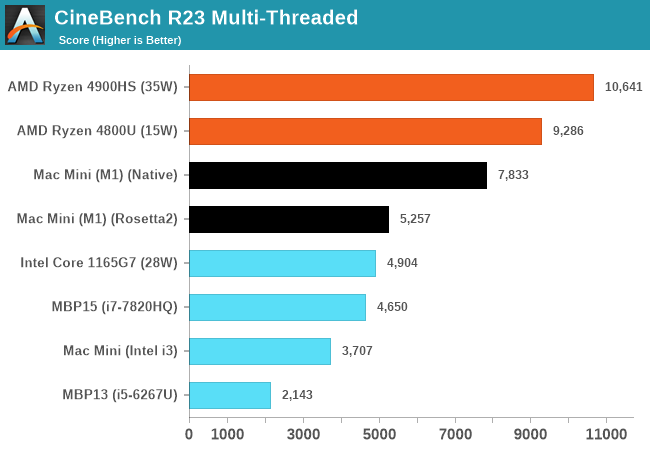
In the multi-threaded R23 runs, the M1 absolutely dominates past Macs with similar low-power CPUs. Just as of note, we’re trying to gather more data on other systems as we have access to them, and expand the graph in further updates of the article past publishing.
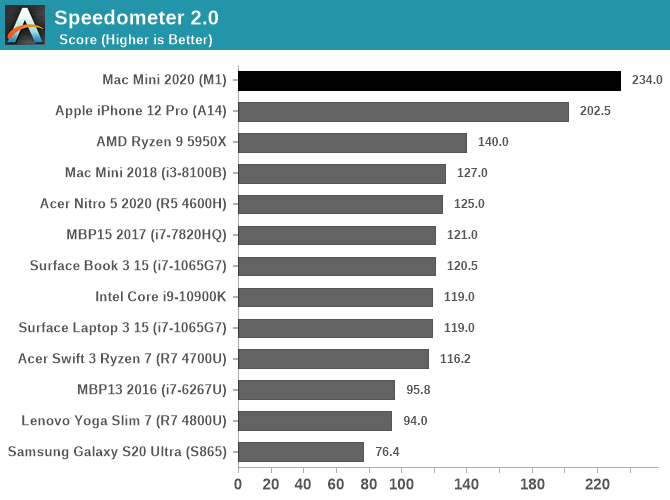
In browser-benchmarks we’ve known Apple’s CPUs to very much dominate across the landscape, but there were doubts as to whether this was due to the CPUs themselves in the iPhone or rather just the browsers and browser engines. Now running on macOS and desktop Safari, being able to compare data to other Intel Mac systems, we can come to the conclusion that the performance advantage is due to Apple’s CPU designs.
Web-browsing performance seems to be an extremely high priority for Apple’s CPU, and this makes sense as it’s the killer workload for mobile SoCs and the workload that one uses the most in everyday life.
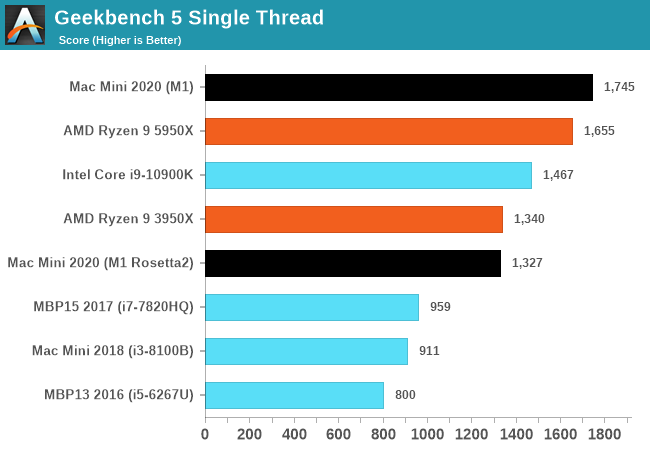
In Geekbench 5, the M1 does again extremely well as it actually takes the lead in our performance figures. Even when running in x86 compatibility mode, the M1 is able to match the top single-threaded performance of last generation’s high-end CPUs, and vastly exceed that of past iterations of the Mac mini and past Macbooks.
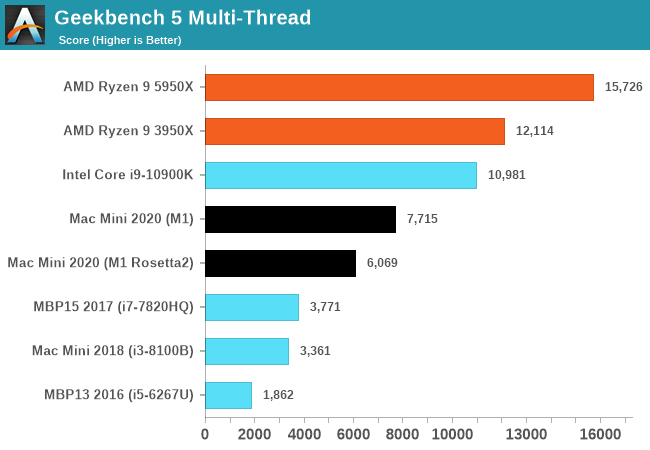
Multi-threaded performance is a matter of core-count and power efficiency of a design. The M1 here demolishes a 2017 15-inch Macbook Pro with an Intel i7-7820HQ with 4 cores and 8 threads, posting over double the score. We’ll be adding more data-points as we collect them.


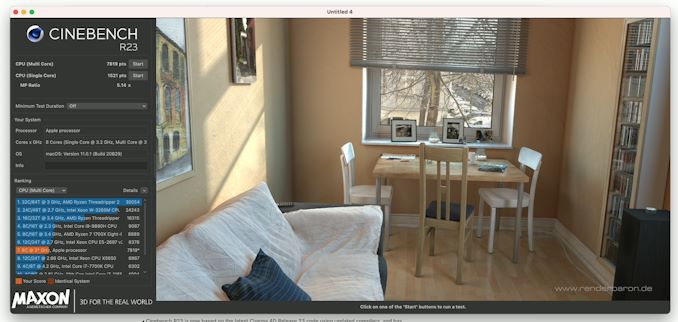








682 Comments
View All Comments
BushLin - Tuesday, November 17, 2020 - link
Meanwhile in reality, 7nm zen 2 is trading results with impressive initial offering by Apple. 7nm zen 3 is available in desktop and 5nm zen 4 becomes available when Apple's exclusively at TSMC ends.Spunjji - Thursday, November 19, 2020 - link
5nm Zen 4 will be contemporaneous with the second generation of M1 on N5P.SarahKerrigan - Tuesday, November 17, 2020 - link
The microarchitecture is Apple, not ARM; this is a fully-custom core.RogerShepherd - Tuesday, November 17, 2020 - link
Architecture is ARMs; microarchitecture is Apple's. And you can speculate about Apple's influence on the ARM V8 architecture.BlackHat - Tuesday, November 17, 2020 - link
Yeah, even the 4500U ryzen, is 27 slower in single core than this chip, with 18 power draw, a zen 3 version with other 19% IPC improvement should be very competitive.BushLin - Wednesday, November 18, 2020 - link
...and that's before we focus on doing some real work in multithreaded tasks.KoolAidMan1 - Tuesday, November 17, 2020 - link
Qualcomm's implementation is a joke. Their performance has been 18 months behind Apple's for the better part of a decade. It isn't as simple as saying "this is an ARM processor" while disregarding that Apple's chip design is so far ahead of everyone else in that space.Intel has been trying to poach their head of chip development (who prior to working at Apple was one of their higher ups) to be their new CEO for over a year now. Apple poached the best around 2008 and this is the payoff.
Nick B - Tuesday, November 17, 2020 - link
Apple has a perpetual ARM licence because they co-founded ARM. Apple does NOT use ARM reference designs, just the licence.haghands - Tuesday, November 17, 2020 - link
The ISA is arm but the microarchitecture is entirely Apple. They've been designing their own cores from scratch since 2012.andreltrn - Tuesday, November 17, 2020 - link
The microarchitecture is nor ARM. The microarchitecture is from Apple and they use the ARM instruct ruction set. Apple was the first to design and produce a 64 bit ARM processor. They did that a year before ARM came out with their 64 bit design.